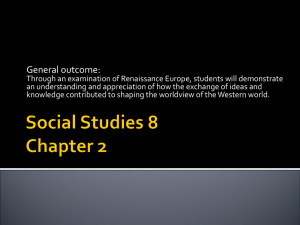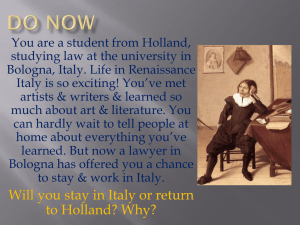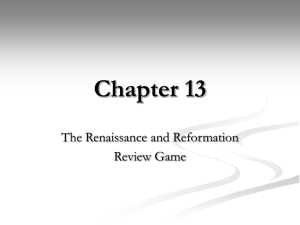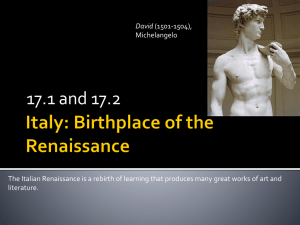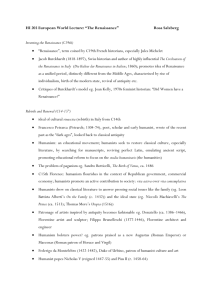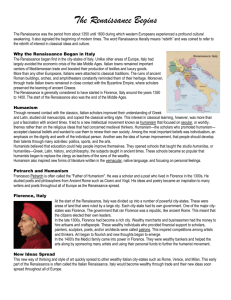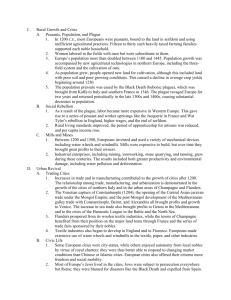Chapter 2
advertisement
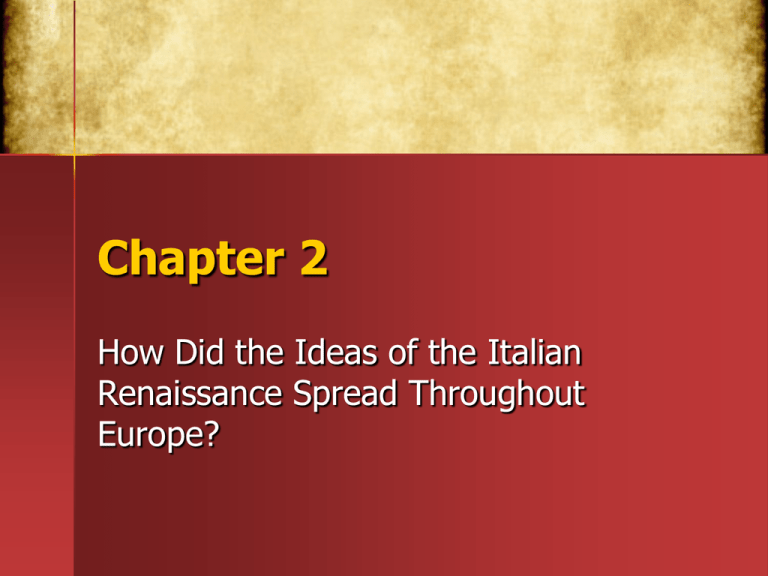
Chapter 2 How Did the Ideas of the Italian Renaissance Spread Throughout Europe? Why Were Ideas Slow to Spread? Geography – What could be some of the factors that caused a slow spread of ideas? – Mountains made traveling from Italia to the rest of Europe, a long and hard journey Why? Feudalism – Upper Class members wanted to protect their way of living by repressing the spread of new ideas Why? Religion – Religious leaders wanted to maintain the status quo, because they had a place of power and influence in the feudal system. Why? War – Money was spent on weapons & training of the soldiers instead of Art and the Renaissance Ideas SO? What Allowed the Renaissance Ideas to Spread? The hundred years war between France and England ended in 1453 – The continent became a safer place to travel Many people moved from the Rural areas to the cities to find work (Urbanization) Feudalism started to decline in Europe, therefore the monarchs started to centralize their power France and Germany attacked the Italian City-States –The invasion exposed the European Monarchs and nobles to the Renaissance worldviews -The monarchs would then have Italian craftsmen and scholars to court. What was Humanism? Humanism was a new way of thinking about life How did Humanism develop? Studies of ancient texts and contact with other cultures led academics to believe that humans had potential to do great things as individuals and not be limited by the strict social roles of the middle ages. What did Humanists believe? Middle ages Humanism Life on earth was to prepare you for the after life. (suffering/giving to the church) Life on earth had value and should be enjoyed. Middle Ages – Humanists Believed: – Lives on Earth should be rich and fulfilled – Surrounded with beautiful art & architecture Enjoyed ideas and sharing philosophies – Humans had the potentials to do great things as individuals They could use their knowledge/creativity to improve society Human potential should not be restricted by social codes. Middle Ages – Humanists Believed: – Maintained their faith and believed in the after life – Although belief in God was important, life on earth had value – Read ancient texts in original language To find their own truths and not those of the translators How did Philosophers Spread the Renaissance Ideas Travelled to Universities around Europe to study and teach – Their students traveled to Italy to learn more about the humanist ideas What do the TMNT have to do with the Renaissance? Named after Renaissance Artists How/Why did art change from the Middle Ages to the Renaissance Doctors and scientists were now allowed to dissect human bodies – Artists were able to create more realistic images More travelling led to shared ideas and development of better techniques Depicted a more personal reflection of how they saw the world Gained more freedom over their subjects and style of creation. Paid for their works Gained status as they became respected for their intellect and creative genius Treated as important contributors to society How did Ideas Spread Among Scientists and Mathematicians Science and math was slow to spread – Religion focused on the afterlife; scientific questioning was discouraged – Europe was very superstitious – Wealthy patrons were more interested in art, so little money went to science – Universities focused on liberal arts But still, ideas led European thinkers to build, expand on, and share knowledge. Asked questions and were interested in searching for the natural causes of events rather then accepting the causes as supernatural How did Writers Influence the Renaissance Worldview? Writers started to compose in their native language. – Vocabularies, spelling, and grammar of the different languages became standardized Increased a common sense of identity among their speakers, readers, and writers Canada Colour Litre Sulphur Valour U.S. Color Liter Sulfur Valor How did the Renaissance Ideas change Social/Economic Systems? Although quality of life was increasing for all, the middle class benefited the most. The rising middle class contributed to the growth of a capitalist society based on trade and money – An economic system that depends on private investment and making a profit Before people bartered, and traded goods rather then using money With an increase of trade goods, manufactured money became widely used –This made it easier to import and set up manufactured systems As the middle class became wealthy, they were able to afford the luxuries that were exclusively for the nobles and higher clergy – New architecture/art/literature ect. People saw they could change their status and became more than their parents The Renaissance Family Extended family-Father, Mother, Children, Grandparents, unmarried and widowed aunts and uncles in one house They worked to support the family Family life was valued and good relations among family was important Father: – ruled the household-Managed finances and property – made all the important decisions for everyone in the household. Mother : – maintained the household-helped husband and children succeed Other Family : – membersworked to support the family The Role of the Children Children: – were considered small adults and participated in family duties. – Respected fathers authority until his death Marriage: – Most marriages outside lower class were arranged – Was a way to try to improve family wealth and status Create financial or political alliances between families Girls around the age of 16 Men in their mid 30’s to early 40’s Women and the Renaissance Although humanists believed in educating both males and females Reality was: – The poor had no opportunity to attend school – Wealthy educated women were regarded as unusual/exceptional Rarely allowed to continue there education when they got married Some of the topics discussed by women writers were: – No intellectual difference between sexes – Women should be educated beyond the preparation for an ornamental life – Some promoted Catholicism – Defended the Reform movement, as well as the right to preach/teach scriptures Even though they were capable, women were not able to take part in decisionmaking process Education Catholic Church was responsible for the education of the nobles and clergy – Taught grammar, rhetoric, logic and Church teachings They were also responsible for keeping European knowledge in libraries A rebirth of knowledge occurred when scholars began to build on ideas previously held by Islamic, and Jewish scholars From this, education changed; – A new philosophy emerged promoting the value of individual human life and personal potential – Students were taught to be good citizens so that they would become leaders in their communities and would carry out civic work People started to ask questions and seek answers rather than accepting what they were told by those in authority Education started to promote the value of human life and potential Artists started to show how they saw the world in there Art Bartering became less popular due to the growing middle class, and currency became widely used Mountains were natural barriers, and slowed the spread of ideas (+) attacking armies take home knowledge that has been learned People learned that they should enjoy life instead of just prepare for the after life War (-) travels avoid the conflict zones




